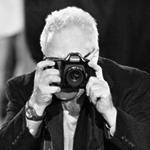 HOME  FORUMS FORUMS  NEWS NEWS  FAQ FAQ  SEARCH SEARCH |
THE ASHER KELMAN ARTICLES
|
|
|
Editorial  Introduction to OPF Introduction to OPF Articles  Ricoh’s GR Digital II Review Ricoh’s GR Digital II Review by John Nevill by John Nevill   Nicolas Claris featured Nicolas Claris featured Sinar Photographer for 2008 Sinar Photographer for 2008  by Asher Kelman by Asher Kelman The Hard Side of Beauty The Hard Side of Beauty by Asher Kelman by Asher Kelman Canon EOS 1D Mark III Report Canon EOS 1D Mark III Report by Arthur Morris by Arthur Morris Seeing Like a Master Seeing Like a Master by Alain Briot by Alain Briot Photography As Art Series Photography As Art Series by Asher Kelman by Asher Kelman The other migrant mother The other migrant mother by Michael Stone by Michael Stone Fast Yachts at Sea, The Journey Fast Yachts at Sea, The Journey of a Captain & his Wife of a Captain & his Wife by Asher Kelman by Asher Kelman Rainer Viertböck’s Travel Rainer Viertböck’s Travel  Photography: Exposing for the Photography: Exposing for the  soul! by Asher Kelman soul! by Asher Kelman Tips for getting a human figure in Tips for getting a human figure in a location shot by Edmund Ronald a location shot by Edmund Ronald Stephen Eastwood an interview Stephen Eastwood an interview by Edmund Ronald by Edmund RonaldThe Team  Membership  About About Read TOS & Register Read TOS & RegisterSubmission  Articles Articles To offer services To offer services Donations Donations Adverts Adverts Sponsorships Sponsorships Contact Contact Meta.editorials In the forums Photography Exhibitions |
OPF is dedicated to the personal vision built into extraordinary photographs. Above all we are most concerned with what's in the image, not just the things, but also the ideas and feelings that move us. So here is the first in a series of short topics which examine how we might be embedding what we feel into our pictures. This article deals with the paradox of context: truth holds us prisoner! I. The Truth Paradox: Art Stymied By Revelation! We say that truth sets one free!
As you can see here, Charles Webster's first image has an indefinite magical quality of uncertain identity, but for sure magnificent. We wonder what could cause the golden columns broken by the water? Ideas of sunsets and magic times come to mind. His subsequent picture shows more context. Those same reflections are again beautiful but a different nature entirely. They come from man-made structures projecting from the water, not the wand of the hand of god as the sun is put away for the day! Not having full context allows us to pose and create our own meanings that transcend the ordinary nature of an isolated piece of fence wire. This, when disclosed in the second picture, changes our perceptions of the first version entirely. Asher Kelman |
HOME  FORUMS FORUMS  NEWS NEWS  FAQ FAQ  SEARCH SEARCH |

